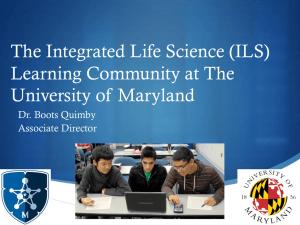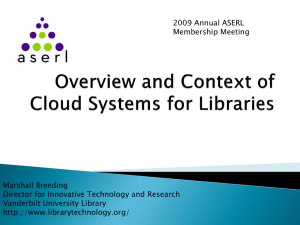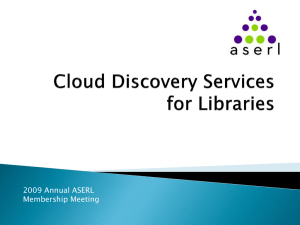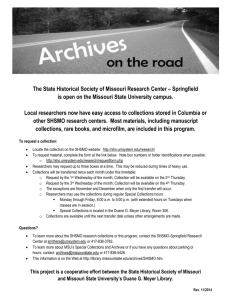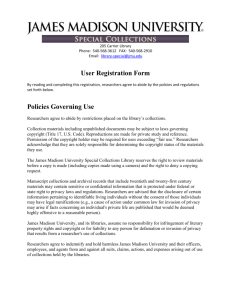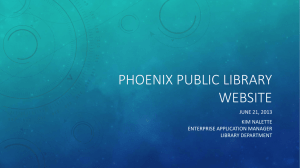Research Services Strategy 2009
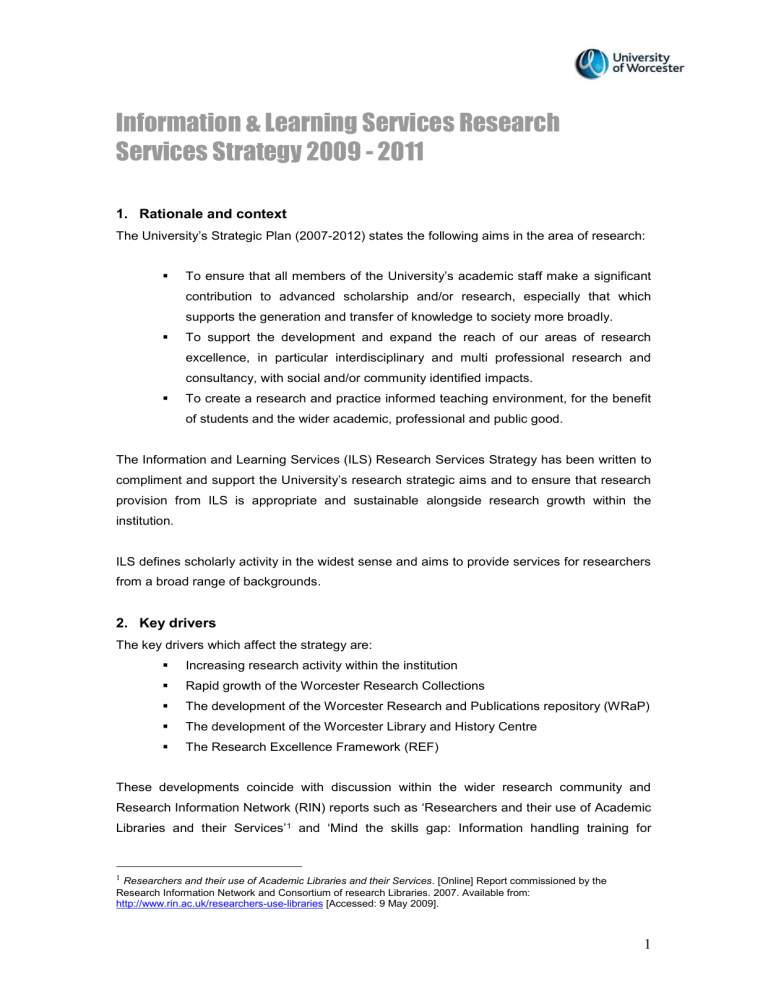
Information & Learning Services Research
Services Strategy 2009 - 2011
1. Rationale and context
The University ’s Strategic Plan (2007-2012) states the following aims in the area of research:
To ensure that all members of the University ’s academic staff make a significant contribution to advanced scholarship and/or research, especially that which supports the generation and transfer of knowledge to society more broadly.
To support the development and expand the reach of our areas of research excellence, in particular interdisciplinary and multi professional research and consultancy, with social and/or community identified impacts.
To create a research and practice informed teaching environment, for the benefit of students and the wider academic, professional and public good.
The Information and Learning Services (ILS) Research Services Strategy has been written to compliment and support the Universit y’s research strategic aims and to ensure that research provision from ILS is appropriate and sustainable alongside research growth within the institution.
ILS defines scholarly activity in the widest sense and aims to provide services for researchers from a broad range of backgrounds.
2. Key drivers
The key drivers which affect the strategy are:
Increasing research activity within the institution
Rapid growth of the Worcester Research Collections
The development of the Worcester Research and Publications repository (WRaP)
The development of the Worcester Library and History Centre
The Research Excellence Framework (REF)
These developments coincide with discussion within the wider research community and
Research Information Network (RIN) reports such as ‘Researchers and their use of Academic
Libraries and their Services’ 1 and ‘Mind the skills gap: Information handling training for
1
Researchers and their use of Academic Libraries and their Services . [Online] Report commissioned by the
Research Information Network and Consortium of research Libraries. 2007. Available from: http://www.rin.ac.uk/researchers-use-libraries [Accessed: 9 May 2009].
1
researchers’ 2 , thus it is recognised that this is an appropriate time to look at current provision for research within ILS and to plan developments for the future.
3. University of Worcester Research Collections
Due to the developing nature of research at the University, ILS staffing resources are directed towards creating a set of niche collections related to current work within the curriculum and
University research foci rather than gathering a broad set of collections.
3.1. Location of the Research Collections
Since the first deposit in September 2005 the Collections have grown exponentially.
Currently, the majority of the Collections are housed in two rooms within the Bredon building. The physical growth of the collections, however, and the range of deposits in terms of subject has recently widened from those centred on children’s literature and childhood to the inclusion of other collections of local and regional importance such as the Kays Archive. The expansion of the Collections requires us to consider a new location.
Key areas of consideration when choosing a location for the collections are:
That the Research Collections be housed in suitable accommodation.
That the accommodation be as controlled an environment as is necessary for the nature of the Collections.
That the accommodation provides sufficient space for growth
Ease of access
It is clear that our optimum solution, in terms of both efficient management and easy access, is to have all research collections housed in the same location. As the
University is on the point of becoming a multi-site institution the decision on permanent location will be part of wider space utilisation discussions within the institution.
The Worcestershire Archaeological Society Collection, (currently located in the
Peirson Library) will transfer to the new Worcester Library and History Centre to complement the History Centre collections.
2
Mind the skills gap: Information handling training for researchers.
[Online] Report commissioned by the Research
Information Network and Consortium of research Libraries. 2008. Available from: http://www.rin.ac.uk/trainingresearch-info [Accessed on: 9 May 2009]
2
3.2 Selection criteria
The following criteria for acceptance of new collections have been identified in order to ensure that collections which are held are well used, enhance the University ’s research reputation, and make a contribution to research collection development nationally.
The University Research Collections exist to support existing or intended research related to University activity. Discussion should be held with the appropriate academic areas about the potential for use by research students before a collection is accepted by the University.
The University Research Collections are developed within the strategic frameworks of the Institute or Department. The decision to acquire collections in newly defined areas should be ratified by the Research and Knowledge Transfer
Committee. Any significant storage or management issues which will carry a financial implication for the University should be drawn to the attention of the
Committee.
Selection criteria will be reviewed on a regular basis to ensure it remains relevant and appropriate to the University’s research policy.
3.3 Accessibility
The ethos of the University is to ensure that the collections are not only available to research staff within the University and in the wider research community but also to the general public who may be interested in the collections for many reasons unconnected with advanced scholarship.
Criteria for access:
Ensure the greatest possible ease of access to all interested parties.
Ensure that researchers have suitable facilities for work within the space allocated to the Collections, e.g. table/desk, socket/wireless access for laptop.
Ensure staffing cover at all times when researchers and visitors are working on the Collections.
The Research Team aims to work towards the establishment of a more formal access policy to be implemented when a critical mass of researchers and visitors has been reached.
3
The Research Team believes that it is imperative that access remains as flexible and accommodating to the needs of the researcher as possible within current staffing levels in order to encourage use.
In addition to providing access to the physical Research Collections it is important that opportunities to digitise sections of the Collections are actively investigated. A digitisation exercise will provide access to material to a much wider audience and will promote the Collections. This activity may provide an opportunity to work with research collection partners.
3.4 Success criteria
Research collections housed together in appropriate location
Collections grow but remain relevant to research within the institution
Collections easily accessed by researchers and general public
The digitisation of parts of the collection
3.5 Key strategic risks
Inappropriate location and splitting of the collections
4 . Resources to support research
ILS has in place, or is developing, a variety of policies and resources to support research.
Services are reviewed on a regular basis and benchmarking is planned to compare services at UW with those at other universities. The views of staff and students will be gathered and used to review current services and to feed into the development of new services.
4.1 The Research Team
In recognition of the growing research agenda within the University ILS has recently created a Research Team to take forward developments in this area, thus extending the staff resource dedicated to research services. The team is made up of the
Research and Partnerships Manager, the Research Librarian and the Research
Cataloguer. In addition, subject specific support is provided by the Academic Liaison
Librarians and a named Elearning Technologist.
4.2 Digital resources
It is recognised that the needs of researchers are specific to their focussed subject area and that researchers carry out much of their work in a range of locations.
‘Researchers now expect to discover, locate and gain access to the information resources relevant to their research on their desktops; and they
4
are creating and gathering unprecedented quantities and varieties of digital information resources in the course of their research.
’ 3
As flexible working practices are relevant to undergraduates as well as postgraduates and researchers, ILS are currently developing an Information Resources
Management and Access Policy (IRMAP) which will look at all aspects of collection management within ILS and which will recommend the purchase of digital resources where ever possible.
In support of resource discovery ILS will implement over the next two years SFX link resolver and MetaLib.
SFX is a link resolver which will allow researchers to link directly from a database or the catalogue to the full text of an article if the institution subscribe to the ejournal. If the full text is not available it will give the user the option to order the item via the Inter Library
Request service.
MetaLib will enable ILS to seamlessly manage a diverse range of electronic resources within a single web interface, such as the library catalogue, reference databases, subject based web gateways and electronic journals. MetaLib allows researchers to create their own quick set search and to save their search history. E-resources are updated on a monthly, weekly even daily basis which means that a search run one day may have more results when run the next.
Citation management is important for researchers therefore ILS have purchased
RefWorks which allows researchers to manage their citations and build up a database of specific references.
4.3 Communication
Communicating with our researchers is essential. ILS currently provides and is further developing a range of hardcopy and online supporting information. All researchers have been sent an ILS pack which includes hardcopy guides of:
Research Survival Guide
Referencing Guides (Harvard & Numerical)
The Additional Needs Guide
IT support Guide
The ILS research website is currently under development but will provide information on the research collections, services for researchers, contacts etc.
3 Ibid.
5
New technologies such as blogs, wikis and Twitter can provide new ways of contacting researchers and informing them of new resources or developments.
Therefore, the research team will investigate how these tools can support research and improve communication.
4.4 Virtual Research Environments (VRE)
As technology advances new tools become available and information/documentation can now be shared virtually in a way it never could before. The JISC have recently funded projects to look at the development of Virtual Research Environments.
.
JISC describe a VRE as:
‘The purpose of a VRE is to help researchers in all disciplines manage the increasingly complex range of tasks involved in carrying out research. A VRE will provide a framework of applications, services and resources to support the underlying processes of research.
’
4
Various platforms are being used for VREs such as Sakai which is being used by
Oxford University and Moodle by Loughborough University. Web 2 technologies are also being utilised. The JISC programme will ‘ define and help to develop the common framework and its associated standards and to encourage others to work within this framework to develop and populate VREs with applications, services and resources appropriate to their needs.
’ 5 ILS will therefore monitor the developments of these projects and visit other institutions to learn from them with a view to developing our own VRE.
4.5 Success criteria
Implementation of the IRMAP
Growth of digital collections
Implementation of SFX & MetaLib
Development and launch of the ILS research pages
Increased use of new technologies for communication
Completed scoping project on the development of a VRE
4.6 Key strategic risks
Lack of increased funding
4
The JISC. Virtual Research Environment: Phase 1.
[Online] Available from: http://www.jisc.ac.uk/whatwedo/programmes/vre1.aspx
[Accessed on: 9 May 2009]
5 Ibid.
6
5. Worcester Research and Publications (WRaP)
Research repositories are an important vehicle for disseminating the research activity of universities. For the individual researcher the benefits include visibility of their research output in easily searchable services such as via Google Scholar. It is now UW policy for all staff research papers to be deposited on WRaP and it is a condition that all PhD theses are also deposited. This is made clear in the WRaP Deposit Policy which is complemented by the WRaP Notice and Takedown Policy. ILS will need to market the new policy to ensure that staff are aware of the deposit policy and the available user support.
It is important that this service operates within copyright law. ILS staff can provide information on good practice within the higher education sector. Clear guidelines and agreements will be used by the service. The WRaP Notice and Takedown Policy outlines the strategy for dealing with possible breaches of copyright.
Repositories such as WRaP are important developments in the field of scholarly communication. The Research Team aims to keep up to date with, and disseminate information about, developments in open access and scholarly communication. Harvesting services, such as the British Library’s EThOSnet, will be used to widen access to UW theses.
5.1 Success criteria
Implementation of WRaP policy
80% deposit of the University research outputs into the repository by
2011
5.2 Key strategic risks
Lack of uptake of the WRaP policy from researchers within the University
6
. The information literate researcher
The report ‘Researchers’ Use of Academic Libraries and their Services’ has highlighted that:
‘researchers must master an array of finding tools that themselves form part of the complexity of materials and services incorporated in modern digital libraries …
Librarians and users must make sense of this cascade, and librarians must be the guides of users in this respect. Skills training is a big issue … 6
ILS staff have been delivering information literacy sessions in this area for the last ten years.
This is not common and should be celebrated as good practice. These sessions have now developed to a stage where a programme of three information literacy sessions is embedded within RTP 401. However, experience suggests that researchers are not only unclear about
6 Researchers’ Use of Academic Libraries and their Service.
Op. Cit.
7
what resources are available but are also unsure about the publishing process in general. The
RIN report also demonstrates that areas such as Open Access and institutional repositories are adding to the researcher’s confusion. In response to this issue Imperial College London developed an online resource that would provide its research community with a holistic overview of information appropriate to the rapidly changing world of scholarly communication.
7
Imperial have given ILS the programme, now known as PILs (Programme of Information
Literacy) and it has been adapted to support Worcester research students. A core part of the programme is the section on the publishing process because scholarly communication was seen as one of the key areas highlighted within the RIN report as an issue for researchers.
The unit looks at peer review, open access, impact factors, copyright, repositories and also introduces researchers to the debate on scholarly communication and open access. ILS will continue to develop the programme and intend to create a ‘PILs’ for academic staff and talk to the Academic Practice Unit about embedding IL into the University’s PG Certificate.
The Research Team aims to disseminate information about the information literacy programme at conferences. Support is available for individual researchers from the Research
Librarian and from the appropriate Academic Liaison Librarian.
6.1 Success criteria
Embedding of PILs into RTP 401
Continuation of development of PILS
Embedding IL into the University’s PG Certificate
6.2 Key strategic risks
Lack of understanding of the importance of IL by researchers
7. Research Excellence Framework (REF)
The REF will replace the RAE. A pilot exercise to test and develop a bibliometric indicator of research quality has taken place with 22 institutions and a report on the pilot is due mid 2009.
The time table for the REF can be seen in Table 1.
It is anticipated that either Web of Science (published by Thomson), which uses journal impact factors to compare the citation levels of different journals or Scopus (published by
Elsevier) will be used to gather citation data. Currently the University subscribes to Web of
7
Boden, D. Gaining a PILOT’s License: Supporting researchers at Imperial College through the Postdoctoral
Information Literacy Online Tutorial . Conference Paper. Konstanz Univeristy Information Literacy Conference.
November 2007.
8
Science so there will be financial implications for the institution should Scopus be chosen for citation gathering. The Research Team will continue to monitor developments so they are fully aware of the implication of the REF for ILS.
Table 1. Timetable for introducing the Research Excellence Framework (REF)
Undertake pilot of bibliometric indicators.
Develop proposals for other aspects of the REF across all subjects.
Spring 2008 to
Summer 2009 Expert Advisory Groups meet to advise us on our proposals.
Assess the impact of our proposals in terms of equality and diversity, sustainability and regulatory burden.
Autumn 2009
Consult on all main features of the REF including operational details of the bibliometrics process, use of other quantitative indicators, subject boundaries and procedures for expert review.
Early 2010 Announce outcomes and next steps following consultation.
Establish expert panels for all subjects.
Calendar year
2010
Undertake bibliometrics assessment (developmental).
Consult on choice and use of assessment components for each subject group.
2011 to 2013
Gradual introduction of REF elements leading to full implementation.
2014-15
HEFCE research funding for all subjects driven by REF from this time onwards.
Higher Education Funding Council for England.
8
ILS will also consider new developments in the area of publications management such as the system Symplectic which includes the functionality to nominate papers for RAE assessment and grant applications, and to upload papers to our institutional repository.
8 HEFCE . Timetable for introducing the Research Excellence Framework. [ Online] Available from: http://www.hefce.ac.uk/research/ref/about/timetable/ [Accessed on: 9 May 2009].
9
7.1 Success criteria
Successfully supporting the University with its data gathering for the REF
Implementation of a publications management system
7.2 Key strategic risks
Lack of investment
8
. Partnerships
The Research Team works closely with the Graduate Research School to ensure that services meet the needs of researchers. Links with external partners, such as Coventry
University and the University of Birmingham, continue to be important and others, such as those with Worcester Cathedral, the Hurd Library and the County Museum Service, are being developed. Staff at UW’s partner organisations can take advantage of services provided by
ILS, such as information literacy sessions highlighted above. This is particularly useful for partner staff embarking on scholarly activity for the first time.
UW is a member of SCONUL Access, a reciprocal scheme providing access to other HE institutions across the UK. ILS staff are active members of national networks and groups such as Inspire.
8.1 Success criteria
Increased number of relevant partnerships
8.2 Key strategic risks
Inappropriate partnerships
9. Marketing
A marketing strategy for the research collections will be developed to include:
Identifying stakeholders
Identifying appropriate communication/dissemination mechanisms to publicise the collections and services to stakeholders
The creation of ILS research pages
The creation of hardcopy promotional material
9.1 Success criteria
Increased use of collections
Increased use of the institutional repository
Increased use of PILs
10
9.2 Key strategic risks
Institutes fail to recognise the importance of the Research Team within
ILS
10. ILS research culture
ILS has a strong research culture across the department which enhances the services we provide to the research community within the institution. The Research Librarian has recently completed her PhD in children’s literature; a number of staff within ILS are research active and have national and international reputations within their respective specialist areas. The department’s research outputs are recorded in the University’s Research Annual Report. ILS also contributes to the research culture of the University by running an Occasional Lecture
Series. ILS will continue to encourage colleagues to submit papers to conferences and to publish in their own professional areas.
10.1 Success Criteria
ILS staff research outputs increase
10.2 Key strategic risks
Lack of time for research
11

